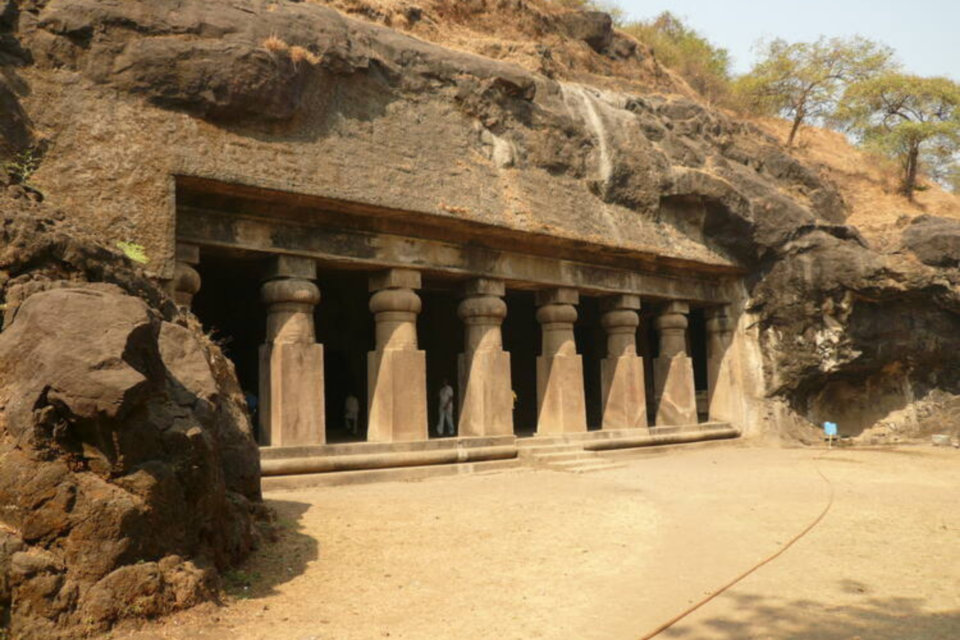The Elephanta Caves, a UNESCO World Heritage Site, are a series of cave temples mostly dedicated to the Hindu god Shiva. They are on Elephanta Island, or Gharapuri (meaning “the city of caves”), in Mumbai Harbor, 10 kilometers east of Mumbai, Maharashtra, India. Five Hindu caves, a few Buddhist stupa mounds dating from the 2nd century BCE, and two Buddhist caverns with water tanks make up the island, which lies about 2 kilometers west of the Jawaharlal Nehru Port.
The Elephanta Caves feature rock-cut stone sculptures, most of which are in high relief, that combine Hindu and Buddhist beliefs and imagery. The caves are carved out of solid basalt. Much of the artwork is vandalized and ruined, with a few exceptions. The direction of the main temple, as well as the relative locations of minor temples, is laid out in a mandala pattern. The sculptures depict Hindu myths, with the most well-known being the massive monolithic 20-foot Trimurti Sadashiva (three-faced Shiva), Nataraja (Lord of Dance), and Yogishvara (Lord of Yoga).
How to reach?
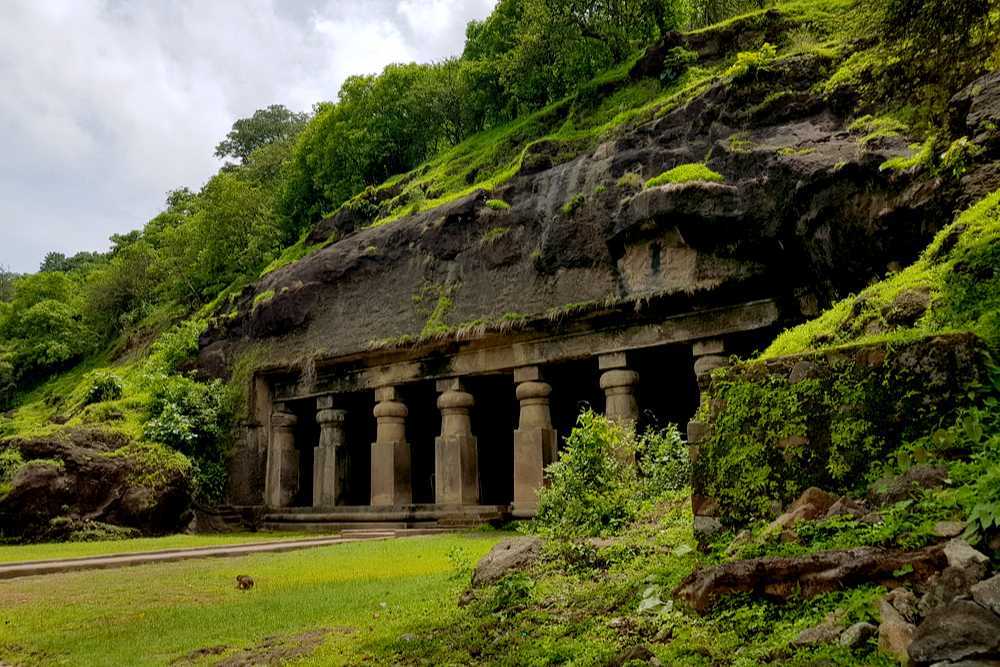
Elephanta Island is about an hour’s boat ride from Colaba’s Gateway of India. From 9 a.m. until 2 p.m., the boats leave every half hour or so. There are two choices: luxurious or mundane. The latest luxury boats aren’t particularly opulent, but they are more comfortable than the older models. The round trip should cost around 200 rupees ($2.79) per person. Tickets can be purchased at a counter at the departure point where the official booking office is located. You can sit on the upper deck for an extra ten rupees, payable on the boat. It is suggested for the best views (including the iconic Taj Palace Hotel and Gateway of India in one frame).
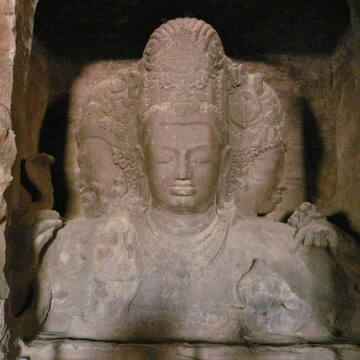
Author: Francesco Bandarin
Once you arrive at the island’s jetty, you’ll need to climb roughly 120 steps to reach the caves’ entrance. Alternatively, the toy train (10 rupees per passenger) or being carried on a chair tied to two wooden poles are options (2,000 rupees per person). However, some stair climbing is unavoidable, so keep that in mind.
How to visit?
Every day except Mondays, the caves are open from 9 a.m. until 5 p.m. To avoid the throng and the heat, visit early in the morning. During the monsoon season of June to August, boat services are discontinued.
Indians pay 40 rupees (56 cents) for entry, whereas foreigners pay 600 rupees (about $8). They are available for purchase at the caves’ entrance counter. A ten-rupee development tax is also imposed.
A souvenir and food stand along the stairwell leading up to the caves. Make sure you have enough food and drink. Keep any consumables away from the pesky monkeys patrolling the area. They have a reputation for being violent and thieving.
Alternatively, you can eat at the government-run restaurant near the cave entrance.
At the caverns, tourist guides are available for hire, and they will most likely approach you. You don’t, however, require one. It’s enough to get a cheap copy of Pramod Chandra’s A Guide to the Elephanta Caves. You can also obtain an insight of the caves’ history by visiting the modest museum (free to attend) located after the ticket counter.

Copyright: © UNESCO
It is possible to take a tour of Elephanta Island. Swadesee offers a fascinating Elephanta Island Experience that also includes the remainder of the island. Also recommended are Mumbai Magic, Breakaway, and Reality Tours & Travel (which includes Sassoon Dock and lunch with a local family).
What to see??
On two separate hills, there are seven caverns divided into two groups. On Gun Hill, Caves 1-5 are Hindu caves dedicated to Lord Shiva (also called Cannon Hill). Buddhist caves 6 and 7 are located on the island’s eastern Stupa Hill, further away. They don’t get a lot of visitors. They’re in bad shape, and one of them is unfinished.
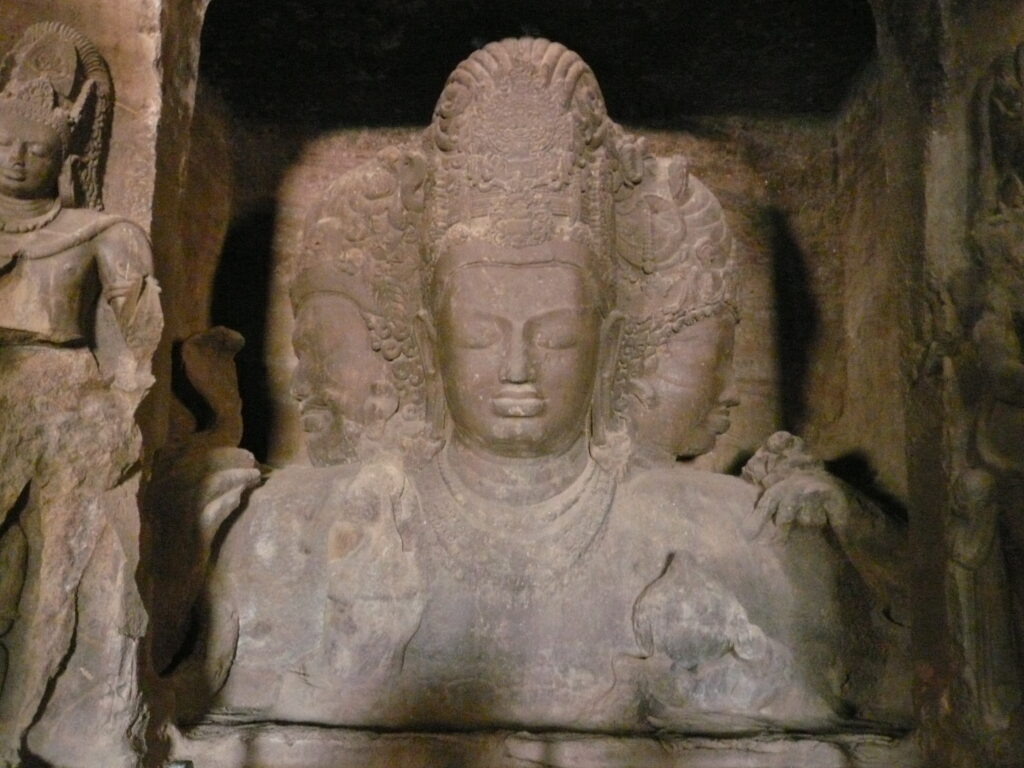
Copyright: © UNESCO
Cave 1 is the main attraction and is the first cave you’ll come upon. It’s difficult not to be awestruck by Lord Shiva’s exquisite carvings in ten various manifestations. The most remarkable is a 7 metre (22 foot) Trimurti, which depicts Shiva as the universe’s destroyer, creator, and preserver.
This cave is frequently compared to Ellora’s Dhumar Lena Cave 29.
Caves 2-4 have fewer carvings and are therefore less interesting.
Climb the crumbling narrow path to the right of the caverns’ entrance to reach the top of the hill, where you’ll find two huge cannons. The summit also offers breathtaking views of the entire island.
If you want a more in-depth experience, go to the island’s settlements to learn about the culture of the Agri and Koli fishing communities who live there. The communities only got electricity in 2018!
Yogishvara (Lord of Yogis) : Located on the left of the entrance the panel shows Shiva seated in padmasana posture and lost in his meditation. Here the lord is represented as a master of the discipline of yoga, the teacher of Yoga arts. It is also known as Mahayogi or Lakulisa, the 28th incarnation of Shiva. He sits on a lotus with a stalk shown as if coming out of the earth, his legs are crossed symmetrically. He wears a crown and expresses great spiritual strength and calmness. The statue is badly damaged with both the upper limbs completely broken. The background contains several smaller statues of gods and goddesses, as well as monks and sadhus, creating a complex collage. Although these statues are badly damaged, one can trace out Bramha, Indra and Vishnu riding their respective vehicles of swan, elephant and Garuda.
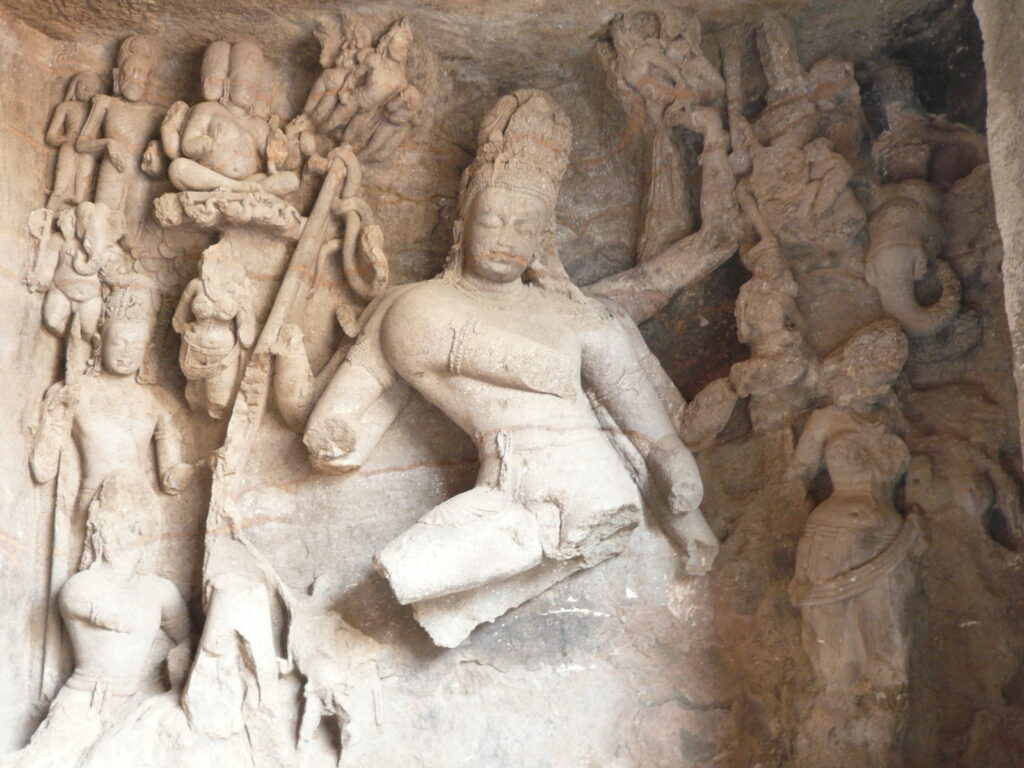
Copyright: © UNESCO
Nataraja (Dancing Shiva): The panel of ‘Nataraja Shiva lies on the right hand side of the main entrance and bangs opposite the Yogishvara panel. Here Shiva represents Nararaj or Nataraja, the king of the dancers. He is seen in lalita mudra. The panel is heavily damaged, with the entire lower portion totally missing. Large portions of the upper limbs have broken off. On the top left corner statues of Bramha, Parvati, Ganesha and Kartikeya can be spotted.
The entrance leads to a huge hall with a tall ceiling supported by a series of colossal columns and a shiva shrine on the left. The southern wall of the main hall houses three magnificent sculptures. On the centre is Trimurthi, on the left is Ardhanarishvara and on right is Gangadhara Shiva.
Trimurti : Trimurti or Mahesh Murti occupies the prime position of the Elephanta caves and no wonder is the star attraction of the cave. The sculpture has a width of 6.55 m and a height of 5.43 m and a depth of 3.2 m. It consists of a three headed statue of Shiva, identified as Mahesa, Mahadeva, or Sadasiva. Each face has its own expression, jewelry and headdress and represents three essential aspects of Shiva: creation, preservation, and destruction. The central face represents the Tatpursha or Mahadeva the creator. With eyes almost closed, he represents Shiva in deep meditation. The right face (left for viewer) represents Aghora, Bhairava or Rudra, the destroyer. The face exhibits curled mustache, bearded, hooked nose and somewhat gruesome appearance. The left head (right for viewers) represents Vamadeva, the preserver. With eyes almost closed it gives a peaceful look. The trimurti is flanked on both sides by statues of guardians deities, accompanied by a dwarf attendant.
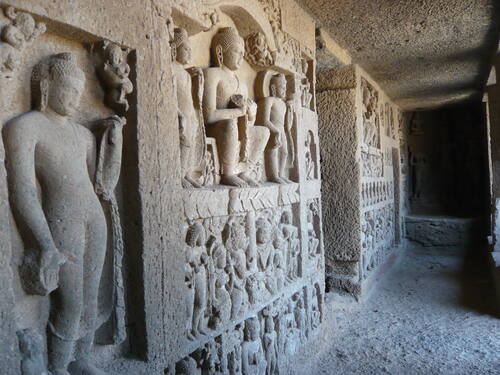
Copyright: © UNESCO
Ardhanarishvara:.On the right of Trimurti (left for viewers) is the panel of Ardhanarishvara, literally meaning the half woman god. The female part represents Parvati while the male part represents Shiva. The male part of the four handed statue leans on a bull (Nandi). The female part with a large breast is elegant with jewelry and holds a mirror in one hand. Numerous other figures crowd the background of the statue creating an elaborate backdrop.
Gangadhara Shiva:.This panel is located on the left of Trimurti (right for viewers). The panel represents the story of Lord Shiva bringing the River Ganges from heaven to earth. The panel shows Lord Shiva and Parvati standing side by side. In between them stands a gana (dwarf jester). Baghirath can be seen kneeling down on the lower left corner. Here also the background contains an amazing collection of minor sculptures, which include Brahma and Vishnu.
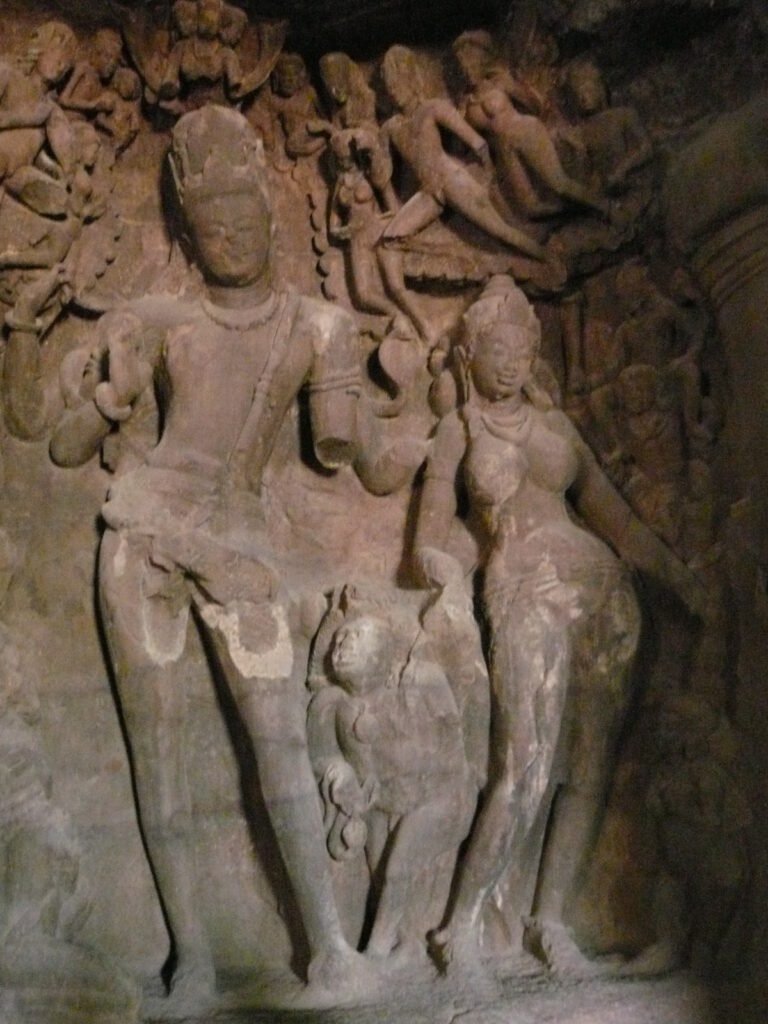
Copyright: © UNESCO
Shiva – Parvati dice game: This panel occupies the south east corner of the main hall of cave 1. The panel shows Shiva and Parvati engaged in a game of dice in Kailash. The scene, representing Kailash Mountain, includes rocky terrain and clouds layered horizontally. Sadly the panel is severely damaged and the face of Shiva badly mutilated. There are traces of a crown and a disc behind Shiva, but it is all damaged. In between the couple stands a female figure with a child in her lap. The background is crowded with accessory figures, many of which have been damaged beyond recognition.

Ravan lifting Kailash: This panel is on the north east corner of the main hall of cave 1. According to legend Ravan wanted to uproot Kailash Parvat, the abode of Shiva, and bring back home to Lanka. He managed to lift the mountain but when Shiva put his left foot on the mountain it settled back to its original position. The panel depicts Ravana at the base while Shiva sits atop with one of his hands he steadies a frightened Parvati. The background behind Shiva is crowded with numerous figures. The panel, especially the lower portion is badly damaged, and several of Shiva’s arm are broken.


